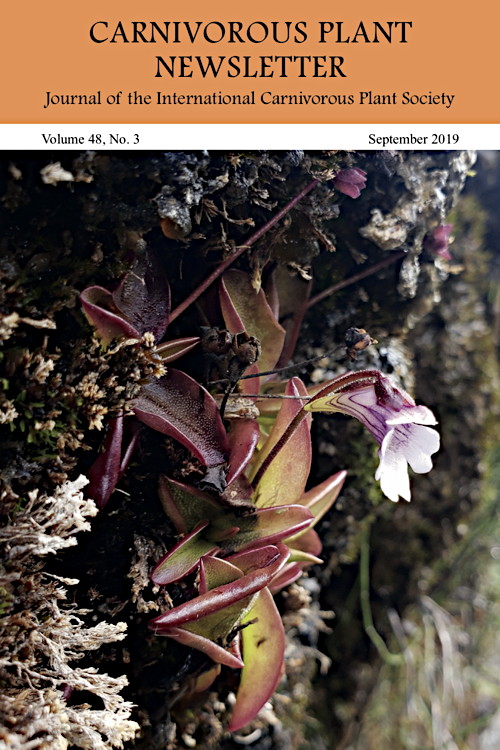|
 Chemistry and surface micromorphology of the Queensland sundews (Drosera section Prolifera). Chemistry and surface micromorphology of the Queensland sundews (Drosera section Prolifera).
Jan Schlauer, Siegfried R. H. Hartmeyer, Irmgard Hartmeyer (2019). Carnivorous Plant Newsletter Vol. 48/3: 111-116.
Keywords: Drosera, Phytochemistry, Naphthoquinones, Chemotaxonomy, Micro-morphology, Trichomes, Emergences.
Jetzt verfügbar / now available: Der vollständige Text / Full text (PDF)

Introduction:
The northern, tropical part of Australia is inhabited by numerous sundew species, of which most are endemic (Brewer & Schlauer 2018). In northernmost Western Australia and the Northern Territory these species predominantly belong to Drosera sections Lasiocephala Planch. (D. banksii, D. subtilis, and the “D. petiolaris group” or “woolly sundews”) and Arachnopus Planch. (the “D. indica group”), while in northern Queensland a further section (D. sect. Prolifera C.T.White, the “rainforest sundews”) of species with rosetted sessile (D. adelae F.Muell. and D. schizandra Diels) or petiolate leaves (D. prolifera C.T.White) adds to this diversity. Droserasect. Prolifera is closely related to D. sect. Arachnopus (Rivadavia et al. 2003; Fleischmann et al. 2018a) but the plants are perennial and they prefer shaded or even forested situations at colline (200-500 m alt.) to montane (500-1000 m alt.) elevations, while the “Indian sundews” are annuals of sunny, usually lowland places. The distributional ranges of the three species of D. sect. Prolifera are geographically well separated from each other, and no native hybrids are known. Nevertheless, the artificial hybridization of D. prolifera and D. schizandra was success-fully performed by Kamil Pasek in the Czech Republic. Unfortunately, the hybrid has not been described formally, so no cultivar name was established (it is, however, commonly on sale under the informal name “Andromeda”).The acetogenic naphthoquinones, plumbagin (P in this paper) and ramentaceone (7-methylju-glone, M in this paper), are important chemotaxonomic markers in sundews (Drosera L., Culham & Gornall 1994; Schlauer et al. 2017, 2018). The Queensland sundews have been screened for their naphthoquinones before (Culham & Gornall 1994) but the chemical diversity within the group has prompted our investigation of the hybrid and, subsequently, a re-evaluation of the published data. Additionally, the close relationship of the Queensland sundews with the “Indian sundews”, which are known for their rich diversity of leaf and stem surface emergences (Schlauer et al. 2017, 2018), has made a micromorphological re-investigation (cf. Seine & Barthlott 1994) of Drosera sect. Prolifera worthwhile.
|
| Deutsche Übersetzung demnächst.
|
References
Brewer, S.J., and Schlauer, J. 2018. Biogeography and habitats of carnivorous plants. In: Ellison, A.M., and Adamec, L. (eds.): Carnivorous Plants: Physiology, Ecology, and Evolution. Oxford University Press, pp. 7-21.
Culham, A., and Gornall, R.J. 1994. The taxonomic significance of naphthoquinones in the Droseraceae. Biochem. Syst. Ecol. 22: 507-515.
Fleischmann, A., Cross, A.T., Gibson, R., Gonella, P.M., and Dixon, K.W. 2018a. Systematics and evolution of Droseraceae. Biogeography and habitats of carnivorous plants. In: Ellison, A.M., and Adamec, L. (eds.): Carnivorous Plants: Physiology, Ecology, and Evolution. Oxford Univer-sity Press, pp. 45-57.
Fleischmann, A., Gonella, P.M., and Rivadavia, F. 2018b. A new sectional name for the Brazilian tetraploid clade of Drosera subgenus Drosera. Carniv. Pl. Newslett. 47: 4-9.
Kondo, K. 1984. Three new species of Drosera L. from Australia. Boletim da Sociedade Broteriana ser. 2, 57: 51-60.
Lowrie, A. 1996. New species in Drosera section Lasiocephala (Droseraceae) from tropical north-ern Australia. Nuytsia 11: 55-69.
Rivadavia, F., Kondo, K., Kato, M., and Hasebe, M. 2003. Phylogeny of the sundews, Drosera (Droseraceae), based on chloroplast rbcL and nuclear 18S ribosomal DNA sequences. Amer. J. Bot. 90: 123-130.
Schlauer, J., and Fleischmann, A. 2016. Chemical evidence for hybridity in Drosera (Droseraceae). Biochem. Syst. Ecol. 66: 33-36.
Schlauer, J., Hartmeyer, S.R.H., and Hartmeyer, I. 2017. Unexpected discovery of 7-methyljuglone (ramentaceone) in several Australian sundews. Carniv. Pl. Newslett. 46: 20-22.
Schlauer, J., Hartmeyer, S.R.H., Hartmeyer, I., Hennern, H., and Hennern, A. 2018. Sundew chemistry and emergence updates. Carniv. Pl. Newslett. 47: 10-17.
Schlauer, J., Hartmeyer, S.R.H., Hartmeyer, I., Hennern, H., and Hennern, A. 2019a. New sundew quinone and emergence data. Carniv. Pl. Newslett. 48(1): 6-12.
Schlauer, J., Carow, T., and Fleischmann, A. 2019b. Quinones from “Gondwanan” sundews. Carniv. Pl. Newslett. 48(1): 13-17.Seine, R., and Barthlott, H. 1994. On the morphology of trichomes and tentacles of Droseraceae Salisb. Beitr. Biol. Pfl. 67: 345-366.
|
|
